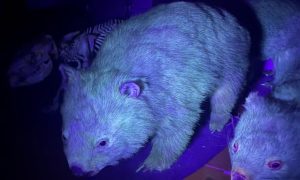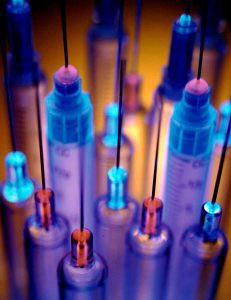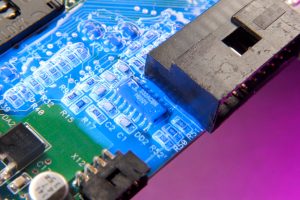
I saw a newsletter article which said that fluorescent animals are much more common than previously thought. Researchers who studied 125 mammal species, including cats, bats, polar bears and wombats (pictured), found that all of them showed some form of fluorescence, and that 86% had fur which actually glowed under UV light. This picture is courtesy of the Western Australian Museum.
I am not completely sure what use fluorescing animals are. But fluorescence is extremely useful in our industry, and many others.
First, get yourself a black light. A black light is a lamp that emits long wave ultraviolet (UV-A, ~365nm) light and very little visible light; typically they are relatively low power. UV-A light has a shorter wavelength than visible light, so you can’t see it. But if you expose a fluorescent material to a black light, then the fluorescent materials absorb the UV light and re-emit it as visible light, which is detectable by the human eye, especially when it is otherwise dark. A very common use is the detection of counterfeit money – you will see a retailer hold your higher value notes under a black light to detect fluorescing patterns. If you have ever watched a CSI: Crime Scene Investigation TV program, you will see a black light used to detect evidence like body fluids, which fluoresce. This technique is also used in NDT (non-destructive testing) for applications like crack detection in metal. Some plastics, such as polystyrene and poly(methyl methacrylate), can naturally exhibit fluorescence when excited by UV light.
 A number of adhesives, coatings and temporary masking materials have a fluorescent tracer added to them, to act as a visual aid for application quality. Most of these fluoresce blue/purple under black light. The fluorescent response will depend on factors like the power of the black light, and the amount of ambient visible light. Often, black light inspections are done in the dark or shielded from ambient light to allow better visible detection of the fluorescence. In a production situation, it is possible to use sensors to detect the fluorescence, and establish a go/no-go check for presence of the adhesive or coating.
A number of adhesives, coatings and temporary masking materials have a fluorescent tracer added to them, to act as a visual aid for application quality. Most of these fluoresce blue/purple under black light. The fluorescent response will depend on factors like the power of the black light, and the amount of ambient visible light. Often, black light inspections are done in the dark or shielded from ambient light to allow better visible detection of the fluorescence. In a production situation, it is possible to use sensors to detect the fluorescence, and establish a go/no-go check for presence of the adhesive or coating.
Many plastics naturally fluoresce blue under UV light – this minimizes the inspection advantages of using blue-fluorescing adhesives in parts assembly. Ultra-Red™ fluorescing adhesives remain naturally clear until exposed to black light, at which point they fluoresce bright red providing a vivid contrast that permits accurate bond-line inspection. A case study shows how a manufacturer of rapid diagnostic medical devices was able to use the red fluorescing feature to ensure process compliance. The latest in adhesives for skin contact wearables has this technology in it.
Fluorescence is very useful if the adhesive and the substrate being bonded are both clear, as it can be tricky to see if there is any adhesive in the bondline at all with the naked eye in ambient lighting. The illustration of needle bonding depicts both blue and red fluorescing needle bonding adhesives.
 In the case of conformal coatings for printed circuit boards, it is almost de rigueur that the coating has a UV tracer in it, and if the coating is meeting specifications like IPC-CC-830 Qualification and Performance of Electrical Insulating Compound for Printed Wiring Assemblies, then it is very much expected.
In the case of conformal coatings for printed circuit boards, it is almost de rigueur that the coating has a UV tracer in it, and if the coating is meeting specifications like IPC-CC-830 Qualification and Performance of Electrical Insulating Compound for Printed Wiring Assemblies, then it is very much expected.
On the other side of the coin, sometimes fluorescence is not a feature which is helpful, for example in optical assemblies where the adhesive fluorescence interferes with an optical measurement or a function. Opti-tec 5001 Optical Epoxy Adhesive has been measured to have very low fluorescence, and would be a useful adhesive candidate for that sort of application.
Posted by Peter Swanson
Peter is the Founder and Executive Chair of Intertronics. He is mostly involved in strategy, recruitment and helping out the Marketing team.
Who's Peter?Categories: adhesives, conformal coating, medical, quality control
